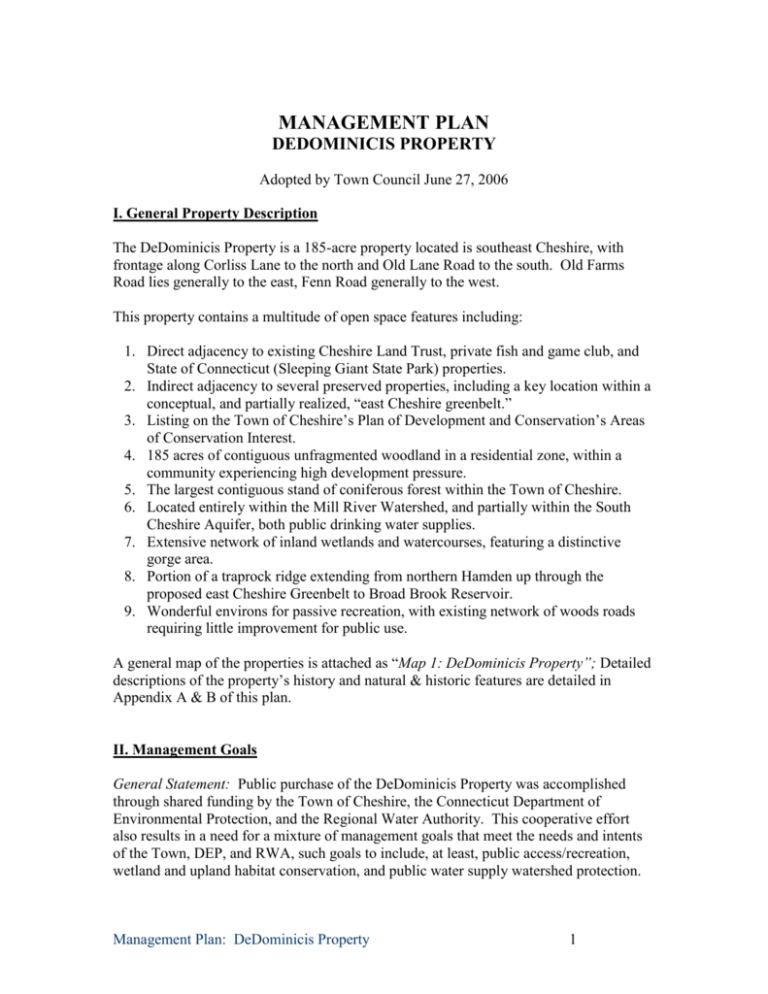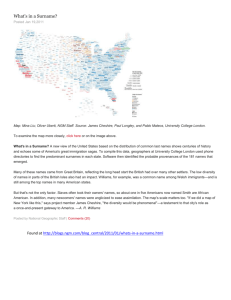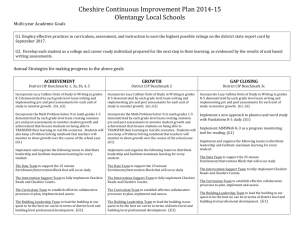Land Management Plan
advertisement

MANAGEMENT PLAN DEDOMINICIS PROPERTY Adopted by Town Council June 27, 2006 I. General Property Description The DeDominicis Property is a 185-acre property located is southeast Cheshire, with frontage along Corliss Lane to the north and Old Lane Road to the south. Old Farms Road lies generally to the east, Fenn Road generally to the west. This property contains a multitude of open space features including: 1. Direct adjacency to existing Cheshire Land Trust, private fish and game club, and State of Connecticut (Sleeping Giant State Park) properties. 2. Indirect adjacency to several preserved properties, including a key location within a conceptual, and partially realized, “east Cheshire greenbelt.” 3. Listing on the Town of Cheshire’s Plan of Development and Conservation’s Areas of Conservation Interest. 4. 185 acres of contiguous unfragmented woodland in a residential zone, within a community experiencing high development pressure. 5. The largest contiguous stand of coniferous forest within the Town of Cheshire. 6. Located entirely within the Mill River Watershed, and partially within the South Cheshire Aquifer, both public drinking water supplies. 7. Extensive network of inland wetlands and watercourses, featuring a distinctive gorge area. 8. Portion of a traprock ridge extending from northern Hamden up through the proposed east Cheshire Greenbelt to Broad Brook Reservoir. 9. Wonderful environs for passive recreation, with existing network of woods roads requiring little improvement for public use. A general map of the properties is attached as “Map 1: DeDominicis Property”; Detailed descriptions of the property’s history and natural & historic features are detailed in Appendix A & B of this plan. II. Management Goals General Statement: Public purchase of the DeDominicis Property was accomplished through shared funding by the Town of Cheshire, the Connecticut Department of Environmental Protection, and the Regional Water Authority. This cooperative effort also results in a need for a mixture of management goals that meet the needs and intents of the Town, DEP, and RWA, such goals to include, at least, public access/recreation, wetland and upland habitat conservation, and public water supply watershed protection. Management Plan: DeDominicis Property 1 Therefore, the following management goals shall be recognized by this plan: 1. The DeDominicis Property shall be managed for a combination of public access and passive recreation, wetland and upland habitat conservation, and public water supply watershed protection purposes. 2. As to public access and passive recreation, this plan recognizes that a major goal and purpose of open space acquisition is for use by the public. Therefore, significant portions of the property shall be available for public use. 3. As to wetland and upland habitat conservation, this plan recognizes that inland wetlands and watercourses are an indispensable and irreplaceable but fragile natural resource with which the citizens of the Town of Cheshire have been endowed. Further, preservation of upland habitats helps to ensures a continuance of native upland biological diversity, and provides a balance to wetland preservation. Therefore, efforts shall be made to preserve/maintain existing wetland and watercourse areas. 4. As to public water supply watershed protection, this plan recognizes that protection of public water supplies safeguards public health, welfare, and safety by reducing risks of contamination, and is vital to ensure an adequate supply of safe, potable water for present and future generations. Therefore, efforts shall be made to manage and maintain the property in a manner that adequately protects public water supplies. 5. As to forest resource management, this plan recognizes that forested landscapes provide a variety of valuable functions within the community including wildlife habitat, watershed protection, and timber resource production. Therefore, efforts shall be made to manage and maintain the property’s forest in a manner that balances ecosystem protection and biodiversity with limited timber resource utilization. III. Permitted Uses General Statement: Permitted uses shall be as described in Section 11-30 Open Space of the Town of Cheshire Code of Ordinances, and any applicable conservation easements, including but not limited to the State of Connecticut Conservation Easement and the Grant of Conservation Restriction in favor of the South Central Connecticut Regional Water Authority recorded on the Cheshire Land Records at Book 1826 Page 157 (attached to this plan as “Appendix / Exhibit C”). Specifically permitted uses shall be as follow, and as indicated on the attached map entitled “Map 2: DeDominicis Property Permitted Uses.” 1. Existing woods roads, or a portion thereof, shall be posted by the Steward as public trail(s) for passive recreation, as described in Section 11-30 Open Space of the Town of Cheshire Code of Ordinances. 2. Horseback riding shall be allowed only on trails identified and posted for such purpose by the Steward. Further, the Steward may close trails to horses during seasonally wet times. 3. Wetlands and watercourses shall be maintained in a natural state. Management Plan: DeDominicis Property 2 4. Given the existing predominance of sugar maples in the property’s northern stand (bounded to the north by Corliss Lane and described in historical documents as “Bristol Meadows”), this area may be investigated by the Steward for maintenance and use as a sugarbush. Clearance for such activity must be sought from both RWA and DEP. Specific proposals shall be solicited by the Steward of such terms as are acceptable to the Steward, presented for Town Council approval, and subsequently monitored by the Steward. 5. Wetlands and woodlands shall be maintained in a natural state. 6. A certified forester shall prepare a forest management plan. The forest management plan shall emphasize goals of, at least, habitat diversity, unevenaged forest structure, invasive species removal (as needed), and sustainable forestry practices. The plan shall specifically call for a segment of the property to be managed in such a way as to encourage development of structural old growth characteristics. Specific proposals shall be solicited by the Steward of such terms as are acceptable to the Steward, presented for Town Council approval, and subsequently monitored by the Steward. 7. The steward shall facilitate arrangement of parking facilities, access, and signage appropriate for carrying out the above-stated goals. IV. Prohibited Uses Prohibited uses shall be as described in Section 11-30 Open Space of the Town of Cheshire Code of Ordinances and all applicable conservation easements, including but not limited to the Grant of Conservation Restriction in favor of the South Central Connecticut Regional Water Authority recorded on the Cheshire Land Records at Book 1826 Page 157. Management Plan: DeDominicis Property 3 Appendix A: History of DeDominicis Property Over the past century the DeDominicis property was part of a larger farm system, likely used primarily for haying, grazing, and woodlot purposes as typically found within the colonial land husbandry systems. Since abandonment for agricultural purposes, the property existed as open space and was used primarily for its horse trails and some minor logging operations. Most recently, the property was considered for development until 2002 when the owners approached the Town about a possible acquisition for open space. The property had been on the Town’s list of Areas of Conservation Interest since the list’s first compilation in 1985. The Town of Cheshire purchased the property on July, 25 2003, from the Aldo DeDominicis Foundation and Clorinda and Enzo DeDominicis. The purchase price was $2,826,310, which was the largest amount paid for a single open space parcel in Cheshire’s history. It was also the second largest open space acquisition ever for the town. The purchase was made possible through an arrangement with the Regional Water Authority, which contributed $555,000, and a state DEP open space grant of $546,000, reducing the town’s net purchase price to $1,724,000. While the DeDominicis Property’s 185 acres are worthy of preservation without adjacency to other preserved properties, successful preservation of this land has also provided several forms of open space linkage. The Cheshire Land Trust’s Old Farms Preserve is a six-acre property actively maintained as meadow habitat. This preserve is located directly adjacent to the southeast portion of the project property. Attached is an extensive list of species spotted both on the Trust’s preserve, and utilizing adjacent woodlands of the DeDominicis Property. The Cheshire Land Trust also owns and stewards the 33-acre Fresh Meadows Wildlife Sanctuary, located north of Cook Hill Road, approximately 1,000 feet north of the DeDominicis Property. The properties are not directly adjacent, but Fresh Meadow’s size and maintenance as a meadow habitat, in juxtaposition with the 185-acres of unfragmented forest on the subject property, provides a habitat mix and interface for wildlife, particularly bird species. A portion of the DeDominicis Property’s eastern boundary is also adjacent to land owned by the New Departure Fish and Game Club. This is a 35.8-acre property, privately owned, which is utilized for shooting practice and fishing by club members. The club stocks its pond, which is upstream of the project property. The Town of Cheshire Plan of Conservation and Development and Conservation’s Open Space chapter identifies an “East Cheshire Greenbelt” as a desirable goal, and the DeDominicis Property is a substantial component toward the realization of this greenbelt. This site was noted as an area of interest as far back as 1985, when the desired acquisition of this property was listed in the Town of Cheshire Plan of Conservation: Areas of Conservation Interest Plan from the same year. Management Plan: DeDominicis Property 4 Appendix B1: Natural/Historical Resources & Terrain Forest Resources The DeDominicis property is currently completely forested. The forests are primarily maple (Acer spp.), American beech (Fagus grandifolia), birch (Betula spp.) and oak (Quercus, spp.). Dense forest stands of hemlock (Tsuga canadensis) and cedar (Thuja occidentalis) occur in the central portion of the property and at some higher elevations. Historic documents including deeds, maps, and airphotos indicate that the majority of the property has been in wooded condition since at least the 1930s. The northwestern portion of the property (“Sheep Lot”) was in open pasture condition until approximately the 1940s. There is currently no agricultural use on the property. The property displays evidence of colonial-era agricultural and pastoral use, and limited past forest management. The current deed makes reference to several colorful names for parts of the property that allude to its agricultural past, such as “Sheep Lot,” “Eel Worm Meadow,” and “Bristol Meadows.” Much of the property was likely cleared for agricultural purposes such as meadows and grassy areas used for grazing and haying, rather than for cultivation of crops. It is possible that portions of the property were managed as woodlands within common colonial-era land husbandry systems. Under such systems, land would be left predominantly in a wooded state. Throughout the property, there are several derelict stonewalls which are evidence of former agricultural usage. There is also a series of significantly large oak trees (Quercus spp.), which a neighboring property owner has reported to be “constitution oaks” planted in approx. 1900 (the size and structure of these trees, however, suggests much older ages). The limbs of these large classic oaks spread laterally, indicating that they were planted and grew prior to forestation of the surrounding area. There is evidence of logging throughout much of the property, the most apparent and recent being two small areas of clear cutting that appears to have occurred approximately 20 years ago. These areas have since filled in completely with even-aged stands of black birch (Betula lenta). Of special note is a projected future track for the property’s forests. The extensive hemlock stands should be monitored for wooly adelgid, which could potentially eliminate hemlock from much of the property. The understory of most hardwood stands is vastly dominated by beech (Fagus grandifolia), and to a lesser extent black birch (Betula lenta). Lack of oak species in the understory is likely due to deer browse by a healthy deer population. Together, these factors could likely result is a dramatic shift in species distributions on the property over the next few decades. Management Plan: DeDominicis Property 5 Habitat To the Town of Cheshire’s knowledge, there are no occurrences of Natural Diversity Database species within or directly adjacent to the project property. However, the size of the property’s unfragmented woodlands, topography, and uplands/wetlands/watercourses mix suggests that the occurrence of valuable native ecological communities is likely within the property. The property likely supports high quality habitats for woodland and wooded stream species, and also habitats that support woodland and meadow species. Water Quality Enhancement/Conservation Protection of the DeDominicis property has water resource importance as it is entirely within the Mill River Watershed. Additionally, approximately 25.3 acres in the property’s northwest corner and 1.3 acres in its southwest corner overlay the Level A South Cheshire Aquifer. Acquisition of the property has therefore assisted with water supply protection for the South Central Connecticut Regional Water Authority. Streams and wetlands are scattered throughout, and surrounding these is a rich assortment of plant and animal life. The significant acreage and the close proximity to existing open space parcels also make it a desirable habitat for wildlife. Hawks, deer, owls, and other animals can be regularly seen on the property, and some of the local residents claim that the streams are full of trout. In addition, there are well marked trails which allow hikers and horseback riders easy access to the scenic beauty of the property. Based on 1990 LANDSAT imagery, the portion of the Mill River watershed containing this property (DEP subregional basin 5302) was estimated to be between 11% and 25% impervious. These percentages of impervious coverage are commonly associated with streams which are likely impacted from existing development, and which can be expected to experience some degradation with further development. Preservation of the DeDominicis Property has therefore assisted with water quality conservation, helping to control impervious surface percentages within this watershed. Terrain The property is varied with some moderately steep elevations alternating with shallow wetlands. There are several steep ridges surrounded by deep wetlands and streams in the alternating valleys, several of which constitute small gorges. In the northeast section of the property there is a particularly deep gorge near the border with the residences of Pine Brook Rd. In addition, there are a number of glacial boulders (erratics) strewn throughout. The varied, pleasant terrain makes the property an especially attractive spot for hikers with some scenic vistas at the higher elevations, especially during winter months. Management Plan: DeDominicis Property 6 Other natural features of note on the DeDominicis Property include the following: 1. A traprock ridge, which traverses the eastern boundary of the property. This subtle ridgeline extends from Hamden up to the southern end of Broad Brook Reservoir 2. Inland wetlands and unnamed watercourses braid throughout the property, all draining to the Mill River, which itself cuts through a small portion of the property’s northwest corner. 3. Of final note is a gorge, which winds through the eastern/central portion of the property. The combination of the gorge’s sharp topography and dense hemlock cover create a habitat area uncommonly found in Cheshire. Several of the property’s streams are likely of high quality for finfish habitat. Management Plan: DeDominicis Property 7 Appendix B2: Flora Description The DeDominicis property is comprised of approximately 185 acres of various habitat communities. Most notable is the expansive stand of healthy, mature Eastern Hemlock (Tsuga canadensis). According to 1990 DEP land cover data, this property encompasses the largest stand of coniferous forest in the Town of Cheshire. Surrounding the coniferous stands are heterogeneous deciduous woodlands comprised of Beech (Fagus grandifolia), Sugar Maple (Acer saccharum), Black Birch (Betula lenta) and Red Maple (Acer rubrum). The entire property falls within the watershed of the Mill River, a tributary to Lake Whitney in Hamden, a public drinking water supply owned by the South Central Connecticut Regional Water Authority. The Mill River flows through a small portion of the property’s northwest corner. Unnamed watercourses cross several portions of the property. A watercourse in the eastern-central portion of the property flows through a gorge, which may possess high ecological value. Abundant populations of native plant species support the banks of the waterways throughout the property: Skunkcabbage (Symplocarpus foetidus), Soft rush (Juncus effusus), Wool grass (Scirpus cyperinus), Upright sedge (Carex stricta), Fox sedge (Carex vulpinoidea) and Broom sedge (Carex scoparia). The trail system throughout the property traverses the diverse habitats of the woodlands and wetlands. The banks of the trails exist as small open pockets for native herbaceous plant populations to thrive. The trails throughout the woodlands are characterized by Pennsylvania sedge (Carex pensylvanica), Woodland aster (Aster divaricatus), White snakeroot (Eupatorium rugosum), Sweet everlasting (Gnaphalium obtusifolium) and Wild Oats (Uvularia sessilifolia). While the trails through the wetlands provide growing areas for Bonset (Eupatorium perfoliatum), Iris species and Carex species. A significant attribute of this property is its’ lack of disturbed soil and vegetation. This factor may contribute to abundance of native plant species with established populations on this property. Non-native invasive species commonly found in disturbed areas such as Phragmites (Phragmites australis), Japanese Knotweed (Polygonum cuspidatum) and Purple loosestrife (Lythrum salicaria) are not present. Management Plan: DeDominicis Property 8







